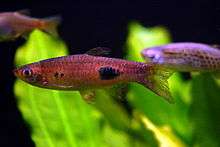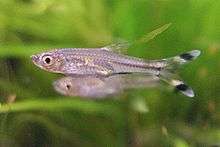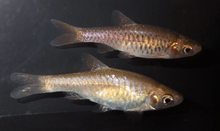Rasbora
Rasbora is a genus of fish in the family Cyprinidae.[1] They are native to freshwater habitats in South and Southeast Asia, as well as southeast China.[1] A single species, R. gerlachi, is only known from an old specimen that reputedly originated from Africa (Cameroon), but this locality is considered doubtful.[2] They are small, up to 17 cm (6.7 in) long, although most species do not surpass 10 cm (4 in) and many have a dark horizontal stripe.[1]
| Rasbora | |
|---|---|
| Silver rasbora (Rasbora argyrotaenia) | |
| Scientific classification | |
| Kingdom: | Animalia |
| Phylum: | Chordata |
| Class: | Actinopterygii |
| Order: | Cypriniformes |
| Family: | Cyprinidae |
| Subfamily: | Danioninae |
| Genus: | Rasbora Bleeker, 1859 |
| Type species | |
| Rasbora cephalotaenia Bleeker, 1852 | |
Several species are regularly kept in aquariums. As a common English name, "rasbora" is used for many species in the genus Rasbora, as well as several species in genera Brevibora, Boraras, Megarasbora, Metzia, Microdevario, Microrasbora, Rasboroides, Rasbosoma, Sawbwa, Trigonopoma and Trigonostigma.[3] Some of these related genera were included in the genus Rasbora in the past. In a 2007 analysis, Rasbora was found to not be a monophyletic assemblage. However Boraras and Trigonostigma were determined to be monophyletic.[4]
Species





According to FishBase there are currently 84 recognized species in this genus.[1] This differs to some extent from the treatment by Catalog of Fishes, where some of these are regarded as junior synonyms and a few others (not listed below) are recognized as valid species.[5]
- Rasbora amplistriga Kottelat, 2000
- Rasbora api Lumbantobing, 2010[6]
- Rasbora aprotaenia C. L. Hubbs & Brittan, 1954
- Rasbora argyrotaenia (Bleeker, 1849) (Silver rasbora)
- Rasbora armitagei N. K. A. Silva, Maduwage & Pethiyagoda, 2010[7]
- Rasbora arundinata Lumbantobing, 2014[8]
- Rasbora ataenia Plamoottil, 2016[9]
- Rasbora atranus Kottelat & H. H. Tan, 2011[10]
- Rasbora atridorsalis Kottelat & X. L. Chu, 1988
- Rasbora aurotaenia Tirant, 1885 (Pale rasbora)
- Rasbora baliensis C. L. Hubbs & Brittan, 1954
- Rasbora bankanensis (Bleeker, 1853)
- Rasbora bindumatoga Lumbantobing, 2014[8]
- Rasbora borapetensis H. M. Smith, 1934 (Blackline rasbora)
- Rasbora borneensis Bleeker, 1860
- Rasbora bunguranensis Brittan, 1951
- Rasbora caudimaculata Volz, 1903 (Greater scissortail)
- Rasbora cephalotaenia (Bleeker, 1852)
- Rasbora chrysotaenia C. G. E. Ahl, 1937 (Goldstripe rasbora)
- Rasbora cryptica Kottelat & H. H. Tan, 2012[11]
- Rasbora dandia (Valenciennes, 1844)[7]
- Rasbora daniconius (F. Hamilton, 1822) (Slender rasbora)
- Rasbora dies Kottelat, 2008
- Rasbora dorsinotata Kottelat, 1988
- Rasbora dusonensis (Bleeker, 1850) (Rosefin rasbora)
- Rasbora einthovenii (Bleeker, 1851) (Brilliant rasbora)
- Rasbora elegans Volz, 1903 (Twospot rasbora)
- Rasbora ennealepis T. R. Roberts, 1989
- Rasbora everetti Boulenger, 1895[12]
- Rasbora gerlachi C. G. E. Ahl, 1928
- Rasbora haru Lumbantobing, 2014[8]
- Rasbora hobelmani Kottelat, 1984 (Kottelat rasbora)
- Rasbora hosii Boulenger, 1895
- Rasbora hubbsi Brittan, 1954
- Rasbora jacobsoni M. C. W. Weber & de Beaufort, 1916
- Rasbora johannae Siebert & S. Guiry, 1996
- Rasbora kalbarensis Kottelat, 1991 (Kalbar rasbora)
- Rasbora kalochroma (Bleeker, 1851) (Clown rasbora)
- Rasbora kluetensis Lumbantobing, 2010[6]
- Rasbora kobonensis B. L. Chaudhuri, 1913
- Rasbora kottelati K. K. P. Lim, 1995
- Rasbora labiosa Mukerji, 1935
- Rasbora lacrimula Hadiaty & Kottelat, 2009
- Rasbora lateristriata (Bleeker, 1854) (Yellow rasbora)
- Rasbora laticlavia Siebert & P. J. Richardson, 1997
- Rasbora leptosoma (Bleeker, 1855) (Copperstripe rasbora)
- Rasbora maninjau Lumbantobing, 2014[8]
- Rasbora meinkeni de Beaufort, 1931[6]
- Rasbora myersi Brittan, 1954
- Rasbora naggsi N. K. A. Silva, Maduwage & Pethiyagoda, 2010[7]
- Rasbora nematotaenia C. L. Hubbs & Brittan, 1954
- Rasbora nodulosa Lumbantobing, 2010[6]
- Rasbora notura Kottelat, 2005
- Rasbora ornata Vishwanath & Laisram, 2005
- Rasbora patrickyapi H. H. Tan, 2009
- Rasbora paucisqualis C. G. E. Ahl, 1935 (Largescaled rasbora)
- Rasbora paviana Tirant, 1885 (Sidestripe rasbora)
- Rasbora philippina Günther, 1880 (Mindanao rasbora)
- Rasbora rasbora (F. Hamilton, 1822) (Gangetic scissortail rasbora)
- Rasbora reticulata M. C. W. Weber & de Beaufort, 1915
- Rasbora rheophila Kottelat, 2012[13]
- Rasbora rubrodorsalis Donoso-Büchner & J. Schmidt, 1997
- Rasbora rutteni M. C. W. Weber & de Beaufort, 1916
- Rasbora sarawakensis Brittan, 1951
- Rasbora semilineata M. C. W. Weber & de Beaufort, 1916
- Rasbora septentrionalis Kottelat, 2000
- Rasbora spilotaenia C. L. Hubbs & Brittan, 1954
- Rasbora steineri Nichols & C. H. Pope, 1927 (Chinese rasbora)
- Rasbora subtilis T. R. Roberts, 1989
- Rasbora sumatrana (Bleeker, 1852)
- Rasbora tawarensis M. C. W. Weber & de Beaufort, 1916
- Rasbora taytayensis Herre, 1924
- Rasbora tobana C. G. E. Ahl, 1934 [6]
- Rasbora tornieri C. G. E. Ahl, 1922 (Yellowtail rasbora)
- Rasbora trifasciata Popta, 1905
- Rasbora trilineata Steindachner, 1870 (Three-lined rasbora)
- Rasbora truncata Lumbantobing, 2010[6]
- Rasbora tubbi Brittan, 1954
- Rasbora tuberculata Kottelat, 1995
- Rasbora vaillantii Popta, 1905
- Rasbora vietnamensis Vasil'eva & Vasil'ev, 2013
- Rasbora volzii Popta, 1905
- Rasbora vulcanus H. H. Tan, 1999
- Rasbora vulgaris Duncker, 1904
- Rasbora wilpita Kottelat & Pethiyagoda, 1991 (Wilpita rasbora)
References
| Wikimedia Commons has media related to Rasbora. |
- Froese, Rainer and Pauly, Daniel, eds. (2016). Species of Rasbora in FishBase. October 2016 version.
- Froese, Rainer and Pauly, Daniel, eds. (2016). "Rasbora gerlachi" in FishBase. October 2016 version.
- Marelius, Charlotte (January 2014). Rasboras—Where do they come from? Showfish, Newsletter of COAST, a Tropical Fish Club in Southern California January 2014. Pp. 1—14.
- Mayden, R.L., Tang, K.L., Conway, K.W., Freyhof, J., Chamberlain, S., Haskins, M., Schneider, L., Sudkamp, M., Wood, R.M., Agnew, M., Bufalino, A., Sulaiman, Z., Miya, M., Saitoh, K. & He, S. (2007): Phylogenetic relationships of Danio within the order Cypriniformes: a framework for comparative and evolutionary studies of a model species. Journal of Experimental Zoology, Part B: Molecular and Developmental Evolution, 308 (5): 642-654.
- Eschmeyer, W.N.; R. Fricke; R. van der Laan (15 May 2018). "Catalog of Fishes". California Academy of Sciences. Retrieved 15 May 2018.
- Lumbantobing, D.N. (2010): Four New Species of the Rasbora trifasciata-Group (Teleostei: Cyprinidae) from Northwestern Sumatra, Indonesia. Copeia, 2010 (4): 644-670.
- Silva, A., Maduwage, K. & Pethiyagoda, R. (2010): A review of the genus Rasbora in Sri Lanka, with description of two new species (Teleostei: Cyprinidae). Ichthyological Exploration of Freshwaters, 21 (1): 27-50.
- Lumbantobing, D.N. (2014): Four new species of Rasbora of the Sumatrana group (Teleostei: Cyprinidae) from northern Sumatra, Indonesia. Zootaxa, 3764 (1): 1–25.
- Plamoottil, M. (2016): Rasbora ataenia, a new freshwater fish from Kerala, India. International Journal of Innovative Studies in Aquatic Biology and Fisheries, 2 (5): 20-24.
- Kottelat, M. & Tan, H.H. (2011): Rasbora atranus, a new species of fish from central Borneo (Teleostei: Cyprinidae). Ichthyological Exploration of Freshwaters, 22 (3): 215-220.
- Kottelat, M. & Tan, H.H. (2012): Rasbora cryptica, a new species of fish from Sarawak, Borneo (Teleostei: Cyprinidae). Ichthyological Exploration of Freshwaters, 23 (1): 37-44.
- Liao, T.Y., Kullander, S.O. & Fang, F. (2010): Phylogenetic analysis of the genus Rasbora (Teleostei: Cyprinidae). Zoologica Scripta, 39 (2): 155–176.
- Kottelat, M. (2012): Rasbora rheophila, a new species of fish from northern Borneo (Teleostei: Cyprinidae). Revue Suisse de Zoologie, 119 (1): 77-87.